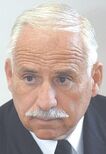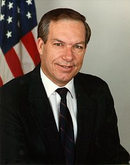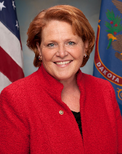
A Revolutionary-era portrait of George Washington, the first President of the United States and originator of many of the traditions surrounding the presidency. The former capital was named after him. The new capital, Torrington, includes a replica of the Washington Monument in his honor.
The The United States of America has had in its history four constitutions. The first, the Articles of Confederation, made no provision for a chief executive. A few years after the American Revolution, the Articles were replaced with the 1787 Constitution, which created the office of President to be the republic's head of state and head of government. The Founding Fathers of the United States vigorously debated what exactly these roles should entail before eventually (thanks to the Federalist Papers published by Hamilton, Madison, and Jay) coming to the agreements that formed the modern office of President of the United States. The Constitution's Article II outlines specific roles, powers, and duties of the President. This article has largely remained in effect through the 1991 and 2010 versions of the revered document.
Below are a list of presidents from the original United States, the American Provisional Administration (Pacific), the Provisional United States (based in Torrington), and the restored USA that replaced it. The current President is Heidi Heitkamp.
Presidents under the Constitution of 1787[]
The 36 Presidents from Washington to L.B. Johnson had all died before the events of September 25, 1983. Shown here are the former Presidents still alive at the beginning of Doomsday, as well as the sitting President and his successor.
| # | Portrait | Name | Took Office | Left Office | Party | Vice President(s) | Notes |
|---|---|---|---|---|---|---|---|
| 37 | Richard Milhouse Nixon | 1969 | 1974 | Republican | Spiro Agnew1, None, and Gerald Ford | A few years after becoming the first U.S. President to resign from office, Nixon moved to Manhattan. He was killed by Soviet ICBMs on Doomsday. | |
| 38 | Gerald Rudolph Ford, Jr. | 1974 | 1977 | Republican | None and Nelson Rockefeller | Ford had two residences in his post-presidency, one in southern California and one in Denver. Both were in areas blanketed by nuclear warheads in the first wave of Doomsday attacks. | |
| 39 | James Earl "Jimmy" Carter, Jr. | 1977 | 1981 | Democrat | Walter F. Mondale | Fleeing by car, ex-President Carter narrowly escaped a missile attack on Atlanta. He arrived as a refugee in the small town of Americus, Georgia. He became the most prominent leader in Georgia's survivor community and is considered the founder and first Governor of Neonotia. | |
| 40 | Ronald Wilson Reagan | 1981 | 1984 | Republican | George H W Bush | The President during Doomsday and World War III, Reagan made the decision to launch a full nuclear counterstrike against the Warsaw Pact. He was in Manhattan for meetings with United Nations officials but was quickly evacuated to the Mount Weather bunker to begin rebuilding the nation. A few months later, he decided to relocate his administration to Hilo, Hawaii. His plane was lost crossing the Pacific. | |
| 41 | George Herbert Walker Bush | 1984 | 1995 | Republican | Robert D. Nesen | Bush became President after Reagan was presumed dead. He had been relocated from Washington to Greenbrier to Colorado. After becoming President, he went to Hilo and led the establishment of the American Provisional Administration in the Pacific. For nine years he worked to restore the American republic in Hawaii, Alaska, the Pacific islands, and the West Coast. He resigned without a direct successor in 1995. |
1 Resigned as Vice President.
Franklin D. Roosevelt was the longest serving President, having been elected to four terms but dying shortly into the fourth. George Bush, the final president, served the second longest having finished out the remainder of Ronald Reagan's term - extended by officials an extra four years - and being elected outright to two of his own before dissolving the office halfway through his second full term.
In the chaos following Doomsday, it was deemed not possible to hold elections as scheduled in 1984, and Bush was named President until the next elections by surviving military and civilian officials, tentatively set for 1988.
Bush would win a term of his own right in the 1988 elections, and a second term in 1992. Those involved deemed this possible, and regarded the 1983-1988 period as a semi-unelected continuation of Reagan's second term, thus allowing it under the 22nd amendment to the Constitution, which would have prohibited Bush from running in 1992 otherwise. The exile community went along with this at the time, deeming it a good idea given the situation - though this has caused dissension in later years, given the events of 1995.
In the years since formal recognition of the continuation of the United States based in Torrington, official lists have retroactively numbered Ray Hunkins as the 42nd President, and so on, with former President Bush's approval and blessing.
Acting Presidents, 1983-1996[]

The four regions
Under the laws and executive orders outlining the USA's continuation of government, anyone in the Presidential line of succession was authorized to serve as Acting President in case of emergency, either for the entire country or part of it. Plans made in early 1984 envisioned four administrations, one led by the President and three by Acting Presidents. One of the four, the Southeast, covering Florida and the Caribbean territories, never came to be. Another, the East, collapsed fairly quickly and was superseded by military governments culminating in the Commonwealth of Virginia. The West also faded; after the murder of Tip O'Neill it was mostly subsumed into the state government of Wyoming. Nevertheless, some of its personnel helped in the formation of the Provisional USA in 1992, and this connection has been cited as one source of the PUSA's constitutional legitimacy. The Pacific administration lasted the longest. It became the American Provisional Administration under George Bush, which folded in 1995-6.
| Portrait | Name | Former role | Place in Succession | Start | End | Region | Capital | Notes |
|---|---|---|---|---|---|---|---|---|
| George Shultz | Secretary of State | 4th | May 8, 1984 | May 30, 1984 | Pacific | Hilo, Hawaii | Shultz took over as Acting President - Pacific when Reagan's plane was lost en route to Hawaii. He took the first steps to organize a federal administration in Hilo. Upon the arrival of the new President, George Bush, he reverted to his former office, Secretary of State. | |
| Robert D. Nesen | Ambassador to Australia | n/a | May 1, 1995 | April 30, 1996 | Pacific | (1) Hilo (2) Juneau (3) Canberra |
Nesen served as George Bush's Vice President throughout the APA era. When Bush stepped down, he took charge of winding down the administration and disposing of its assets. He filled one of the three presidential roles, acting as Chief Executive but not Head of State or Commander-in-Chief, and never claimed any presidential title. | |
| George Bush | Vice President | 1st | May 6, 1984 | May 11, 1984 | West | Leadville, Colorado | Bush served as Acting President - West for only a few days, between his departure for Colorado and the news that Reagan's plane had been lost. Immediately thereafter he took the Oath of Office to become President in his own right. Soon after, he left for Hawaii. | |
| Tip O'Neill | Speaker of the House of Representatives | 2nd | May 23, 1984 | November 20, 1986 | West | Leadville | Bush left O'Neill in charge at Leadville. As the nearby NORAD facility began to shut down, O'Neill had to work more closely with the Wyoming state government, the strongest civil authority nearby. He was assassinated by an angry citizen who blamed the federal government for the nuclear war. | |
| Donald Hodel | Secretary of Energy | 15th | November 20, 1986 | c. 1988 | West | (1) Rock Springs, Wyoming (2) Casper |
Hodel moved the administration to Wyoming and oversaw the transfer of NORAD and other personnel to the emergency state government. By 1988 he was no longer acting in any presidential capacity. He served in the provisional cabinet of President Hunkins before his election, representing continuity from the old administration to the new. | |
| Strom Thurmond | President pro tempore of the Senate | 4th | April 27, 1984 | February 28, 1986 | East | Charleston, West Virginia | Thurmond was designated Acting President - East when Reagan and Bush left Appalachia. The 81-year-old had difficulty exercising effective power in that chaotic environment. He ceded his responsibilities to the local National Guard, who took over administration of the city. | |
| Donald Regan | Secretary of the Treasury | 5th | February 28, 1986 | August 10, 1988 | East | (1) Charleston (2) Mount Weather |
Regan would have served as Acting President– Southeast but never did. In West Virginia, he asserted that Thurmond had effectively resigned and claimed to be his successor as the lawful chief executive for the East. This provoked a standoff with the Guard, and he was forced to return to Mount Weather. As the facility became inoperable, Regan abandoned the administration. | |
| Raymond Donovan | Secretary of Labor | 11th | August 10, 1988 | April 25, 1994 | East | Romney, West Virginia | Succeeding Regan, Donovan relocated deeper in the mountains with what was left of the administration, taking over the government of Hampshire County. When the Commonwealth of Virginia was consolidating its control of the region, Donovan reasserted his title and sought to play a part in the new regime. Rebuffed and threatened with a sedition charge, he finally stepped down, ending the last gasp of the Administration - East. |
Presidents under the Constitution of 1991[]
| # | Portrit | Name | Took Office | Left Office | Party | Vice President(s) | Notes |
|---|---|---|---|---|---|---|---|
| 42 | Raymond "Ray" Hunkins | 1992 | 2001 | Republican | Allen Kolstad | Acclaimed as the hero of the Lakotah War, Hunkins was named president of the Constitutional Convention of 1991 and then Provisional President of the nation. His title became simply President aafter his 1992 election and 1993 inaguration. Once the demise of the APA was widely known, official records numbered him the 42nd President. | |
| 43 | Mike Sullivan | 2001 | 2005 | Democrat | Richard H. Stallings | ||
| 44 | Wayne Allard | 2005 | 2013 | Republican | Mike Simpson | ||
| 45 | Mike Simpson | 2013 | 2021 | Republican | Sam Brownback | ||
| 46 | Heidi Heitkamp | 2021 | Present | Democrat | Steve Bullock | Heitkamp's election made her the first female President of the United States. |
When the then-Provisional United States ratified their constitution in 1991, a Presidential election was scheduled for the following year. Aside from the reform of the Electoral College and the end of the appointment of electors, the Presidency remains essentially unchanged from the 1787 constitution. Both Hunkins and Allard have served two terms, tied for most under this Constitution. Three of the Presidents are members of the Republican Party, with two Democrats, and one served as Vice President before being elected President.
Living Presidents[]
| President | Term of office | Date of birth |
|---|---|---|
| Jimmy Carter | 1977–1981 | October 1, 1924 |
| Ray Hunkins | 1992–2001 | April 17, 1939 |
| Mike Sullivan | 2001–2005 | September 22, 1939 |
| Wayne Allard | 2005–2013 | December 2, 1943 |
| Mike Simpson | 2013-2021 | September 8, 1950 (age 72) |
| Heidi Heitkamp (incumbent) | 2021-Present | October 30, 1955 (age 66) |
See also[]
| ||||||||||



















